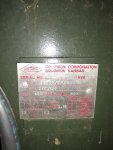electrofelon
Senior Member
- Location
- Cherry Valley NY, Seattle, WA
- Occupation
- Electrician
191005-2351 EDT
electrofelon:
I have a 50 kVA pole transformer, some wire to my meter, a small additional amount of wire, main fuses, and then one circuit breaker. With about a 10 A 120 V load the 120 loaded bus to neutral bus has a voltage change of about 0.9 V. This does not include the breaker.
A 240 V 10 A load would probably produce about a 1.0 V change. I can explain why if need be. The 50 kVA transformer will probably look like about 0.25 V change for a 10 A load change, but a good amount of this is at 90 deg.
If you pump back 80 A at 240 V, then for my parameters the hot to hot bus voltage will possibly increase by 8 V. My nominal at present is 123 V, which is quite normal, but sometimes rises to over 125 V. With either of these nominal values an 8 V increase would take me over 246+8 or 250+8, half at 120. Can equipment in my home tolerate voltage that high? Probably, but should not.
If I put an interposing transformer between the PV system and my main panel, then I can reduce the voltage the inverter sees, but it does not correct the voltage in my home. I can also put the whole home load and inverter on the output of the interposing transformer. This increases source impedance.
.
I just did a measurement here and I get 1.5V drop when I turn on 2KW of 240V electric heat (8 amps). I have 25 KVA utility transformer -> 80' 4/0 AL -> 15 KVA 240-2400 transformer -> 1900' #12 CU -> 15 KVA 2400 - 120/240 transformer feeding house. There is a tap off the 2400 side of the house transformer which is 600' #10 CU -> 15 KVA 2400 - 240 transformer for PV system. So this gets to what you were saying : The house still "sees" the voltage drop/rise of some of the system, but not the PV transformer. I think it is good this way as it keeps a few more volts of voltage swing off the house and I can do what I want with the voltage at the PV system if needed.
I am surprised by your voltage change figures, that they are that high. I guess my setup isnt so bad considering the multiple transformers and wire runs. That is the thing with PV systems, it essentially doubles the voltage swings. I figure about 60 amps would be max load at the house, but I can have 60 amps going the other way so essentially doubling my voltage variation. I might have gone a bit tighter with everything when I designed it, but at the time I had a slightly different philosophy and was only going to have a small PV system and not as much electric loads. I should be fine if I keep my L-G voltage between 110 and 125 at the house.


